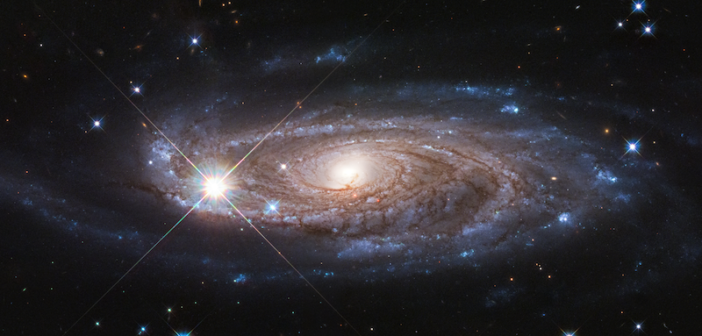Editor’s note: Astrobites is a graduate-student-run organization that digests astrophysical literature for undergraduate students. As part of the partnership between the AAS and astrobites, we occasionally repost astrobites content here at AAS Nova. We hope you enjoy this post from astrobites; the original can be viewed at astrobites.org.
Title: Detection of a Superluminous Spiral Galaxy in the Heart of a Massive Galaxy Cluster
Authors: Ákos Bogdán et al.
First Author’s Institution: Center for Astrophysics | Harvard & Smithsonian
Status: Published in ApJ
Galaxy clusters contain hundreds of galaxies in a huge variety of shapes and sizes, ranging from irregular dwarf galaxies to giant ellipticals. The most luminous member of a cluster is known as the brightest cluster galaxy. Each brightest cluster galaxy is different, but there are some properties that they tend to have in common — most brightest cluster galaxies are found at the very centre of their host cluster and are large, elliptical galaxies, containing little gas and forming very few new stars.
The reason why most brightest cluster galaxies look so similar is well understood, as it is thought that these large galaxies form via a series of galaxy mergers. These are violent cosmic events that slowly increase the size of the galaxy, whilst also destroying any delicate disk or spiral arms that the galaxy may have (click here to see a simulation of two merging spiral galaxies). Additionally, mergers can lead to gas being expelled from a galaxy, resulting in the gas-poor, quenched brightest cluster galaxies that we see today.
However, today’s article presents an exciting twist to this story by presenting data from three galaxy clusters that do not appear to follow this trend, including one brightest cluster galaxy that doesn’t fit with our current theories at all.
Suspicious Spirals
The authors begin by introducing seven superluminous spiral galaxies, a recently discovered class of huge galaxies with spiral or lenticular shapes. The great size of these galaxies is what motivates the main question of today’s article: could these superluminous spiral galaxies actually be brightest cluster galaxies, despite not looking like them?
To answer this, we can look at the amount of X-ray radiation surrounding these galaxies. X-rays are emitted by the intracluster medium, a vast cloud of incredibly hot gas that fills a cluster, occupying the space between galaxies: if a cluster was a tasty chocolate chip muffin, the intracluster medium would be the cake, filled with chocolate chip galaxies. Using the X-ray telescope XMM-Newton, the authors found no X-ray emission surrounding two of their galaxies. However, as Figure 1 shows, the remaining five have large amounts of X-rays being produced nearby. This indicates the presence of the intracluster medium, meaning that these galaxies are nearby to a galaxy cluster.

Figure 1: X-ray observations of the region surrounding each of the seven superluminous disk galaxies. Regions of stronger X-ray emission are represented by lighter colour, and the centre of each X-ray region (i.e., the cluster centre) is marked by a green cross. The position of each superluminous disk galaxy is shown by the green circle. Note that the two galaxies in the bottom right (J11380 and J09354) have no associated clusters, and that the top-left galaxy (J16273) is located at the centre of its cluster. [Adapted from Bogdán et al. 2022]
Galaxy Mergers, but Not as You Know Them
The fact that J16273 is the brightest galaxy in a cluster and lives right in the cluster centre makes it look like a fairly typical brightest cluster galaxy. However, brightest cluster galaxies are elliptical because of the large numbers of galaxy mergers that they experience. How can we explain why this one is so different from all of those that we’ve seen before?
Surprisingly, one explanation is mergers themselves. The authors suggest that J16273 was previously a regular, elliptical brightest cluster galaxy that recently merged with a smaller gas-rich galaxy. Under the right conditions, this merger could spin up the elliptical galaxy, with the remnants of the gas-rich galaxy forming a brand new spinning disk.
In order to really understand these giant spiral galaxies, future work will need to look at many more than just seven of them. The authors acknowledge this and suggest that eROSITA, an ongoing X-ray survey of the sky, will be able to look at many more of these galaxies and determine whether they live in clusters, groups, or alone. eROSITA is due to release its first data at the end of 2022 and should help us to solve the mystery of how these huge spirals ended up in places we never expected to find them.
Original astrobite edited by Katy Proctor.
About the author, Roan Haggar:
I’m a PhD student at the University of Nottingham, working with hydrodynamical simulations of galaxy clusters to study the evolution of infalling galaxies. I also co-manage a portable planetarium that we take round to schools in the local area. My more terrestrial hobbies include rock climbing and going to music venues that I’ve not been to before.
